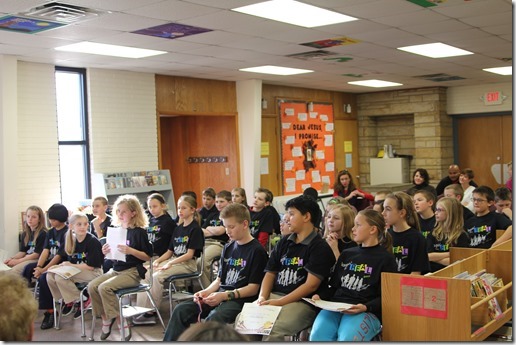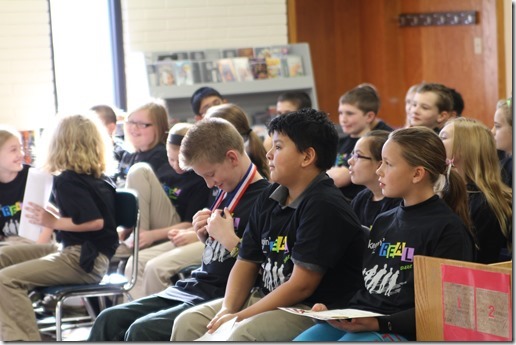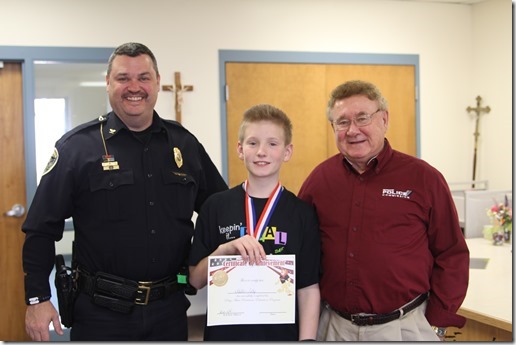Today was the graduation for D.A.R.E. After the ten week class culminated, the students wrote essays reflecting upon their experiences. A few days ago, Walker’s teacher called to ask if he would be willing read his at the graduation. What I didn’t realize until I hung up with her was that Walker’s essay was chosen as the best from his class. Walker was absolutely willing!

 Everyone received a certificate for completing the class but Walker and Maren (the other essay winner) also received a medal.
Everyone received a certificate for completing the class but Walker and Maren (the other essay winner) also received a medal.
The Lesson That D.A.R.E. Taught Us
By Walker Selby
Wow! What an interesting ten weeks having D.A.R.E. class with Chief Sprinkle this has been! D.A.R.E. is a program that teaches students how to stand up to bullying, to avoid drugs, and to stay safe. D.A.R.E. stands for “Drug Abuse Resistance Education.” It really helps children our age to make safe and responsible choices while we are becoming teenagers. As a group, we learned about substance abuse, bullying peer pressure, signs of stress, consequences, responsibility, effective listening, and nonverbal communication. D.A.R.E. is a program I will remember my whole life because it helps us make the right choices when we need to make important choices.
D.A.R.E. taught us the harmful heath effects of and how people use alcohol, drugs, and tobacco. Alcohol will weaken the heart and cause loss of coordination, poor judgment, memory loss, loss of self-control, and slow reflexes. Drinking too much alcohol will slow down your body and may even cause comas and death. Alcohol goes into the bloodstream and can damage every organ in your body. If you are under twenty-one years old, it is illegal for you to consume alcohol. Every year in the United States over 75,000 people die due to alcohol related deaths. Most teenagers don’t drink alcohol, but mixing alcohol and medicine is extremely dangerous. Drinking as a teen is more damaging than as adults because teenagers’ bodies are growing and changing. The nicotine in cigarettes and in chewing tobacco reduces the amount of blood flowing to your brain and interferes with the way your brain works. Smoking cigarettes may cause heart disease, and peoples who smoke have more colds and upper respiratory problems than people who don’t smoke. Smoking may also lead to lung cancer. Chewing tobacco can cause mouth cancer, tooth loss, and other health problems. Smoking and chewing tobacco can yellow your teeth, cause bad breath, dry your skin, and cause wrinkles. In the United States, it is illegal to sell tobacco products to anyone under the age of eighteen (nineteen in some states). In a cigarette, there are more than 200 known harmful chemicals. Smoking is the most preventable cause of death in this country today. More than 400,000 Americans die each year from tobacco related causes. Almost 50,000 deaths per year can be attributed to secondhand smoke. Now that I know how dangerous and how it affects my health, I will refuse drugs, alcohol, and tobacco when I am offered them.
One of many strategies that D.A.R.E. taught us was how to stand up to something that happens to many kids our age —bullying. I learned about the many types of bullying: cyber bullying, group bullying, and many more types. The five W’s of safely reporting bullying are: Who: “Who was it?” What: “What did he/she do?” When: “When did it happen?” Where: “Where did it happen?” Why: “Why did he/she do it?” Remembering to report safely, maybe by telling a trusted adult, through a school form or by telling the bully’s parents, make sure that you are telling, not tattling. Tattling is if they are talking in class and you tell the teacher, but nobody is being hurt. Telling is if you are being bullied or another something serious and you tell. Don’t be afraid to tell. If you don’t tell, the problem will just get worse. Bullying is not fun, so make you are not being a bully or allowing yourself to be bullied.
One of the benefits this D.A.R.E. program has to offer is the D.A.R.E. Decision Making Model or the D.D.M.M. The four steps of the D.A.R.E. Decision Making Model are: Define, Assess, Respond, and Evaluate. In a situation that involves drugs, alcohol, tobacco, or bullies, I will use this strategy. The first step, Define, helps us thinks before we do something unsafe. Another step, Assess, lets us consider our choices. The third step, Respond, lets us decide on a choice. The final step, Evaluate, lets us see if we have made the right choice. You can make sure you are doing the steps in the correct order if you take the first letter from each of the steps and see if they spell D.A.R.E. Define, Assess, Respond, and Evaluate is the correct order because the letters spell D.A.R.E. The D.A.R.E. Decision Making Model will help us to make safe and responsible choices and resist the temptation of alcohol, tobacco, and drugs.
In these ten weeks, we have learned so much in D.A.R.E. I learned about bullying, the harmful effects of drugs, alcohol, and tobacco abuse, and how to use the D.A.R.E. Decision Making Model. For the rest of my life, I will stay safe and resist drugs. This program helped me, and I hope it will assist other young people too. I would like to thank the individual who made it all possible Chief Sprinkle. Thank you Chief Sprinkle for taking your valuable time to teach our class to DARE to stay away from drugs, alcohol, and tobacco, and prevent bullying in school.



Congratulations, young Mr. Selby. You certainly wrote a wonderful essay and deserved your medal.
You must be proud of all you learned.
BTW, are you taller than your teacher as well as your grandmother.
Wow! What a cool medal to be awarded! The essay was fantastic, what a smart kid!
xoxo Kim